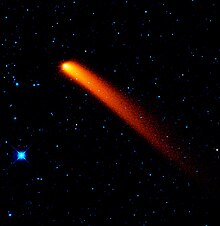astro.wikisort.org - Comet
C/2007 Q3 (Siding Spring), is an Oort cloud comet that was discovered by Donna Burton in 2007 at Siding Spring Observatory in New South Wales, Australia.[6] Siding Spring came within 1.2 astronomical units of Earth and 2.25 AU of the Sun on October 7, 2009.[1] The comet was visible with binoculars until January 2010.[6]
 WISE infrared image of C/2007 Q3 January 10, 2010[1] | |
| Discovery | |
|---|---|
| Discovered by | Donna Burton Siding Spring Survey 0.5-m Schmidt (E12)[2][3] |
| Discovery date | 2007 August 25 |
| Orbital characteristics A | |
| Epoch | 2455014.5 (2009-Jul-02) |
| Orbit type | Oort cloud |
| Aphelion | ~69,000 AU (inbound) ~15,000 AU (outbound)[4] |
| Perihelion | 2.25166 AU (q) |
| Semi-major axis | ~7,500 AU (outbound)[4] (a) |
| Eccentricity | 1.0002077[5] |
| Orbital period | Millions of years (inbound) ~650,000 yr (outbound)[4] |
| Inclination | 65.6504° |
| Jupiter MOID | 3.13 AU |
| Last perihelion | October 7, 2009 |
Images of the comet taken in March 2010 by N.Howes using the Faulkes telescope, showed that the nucleus had fragmented.[7]
The comet has an observation arc of 1,327 days and is still been observed as of April 2011.[5] The orbit of a long-period comet is properly obtained when the osculating orbit is computed at an epoch after leaving the planetary region and is calculated with respect to the center of mass of the solar system. Using JPL Horizons, the barycentric orbital elements for epoch 2030-Jan-01 generate a semi-major axis of 7,500 AU, an apoapsis distance of 15,000 AU, and a period of approximately 650,000 years.[4]
Before entering the planetary region (epoch 1950), C/2007 Q3 had a calculated barycentric orbital period of ~6.4 million years with an apoapsis (aphelion) distance of about 69,000 AU (1.09 light-years).[4] The comet was probably in the outer Oort cloud for millions or billions of years with a loosely bound chaotic orbit until it was perturbed inward.[8]
References
- "Visitor from Deep Space". NASA. February 17, 2010. Retrieved on February 19, 2010.
- "IAUC 8865: P/2007 Q2; C/2007 Q3". IAU Central Bureau for Astronomical Telegrams. 2007-08-30. Retrieved 2011-04-20.
- "MPEC 2007-Q44 : COMET C/2007 Q3 (SIDING SPRING)". IAU Minor Planet Center. 2007-08-30. Retrieved 2011-04-20.
- Horizons output. "Barycentric Osculating Orbital Elements for Comet C/2007 Q3 (Siding Spring)". Solution using the Solar System Barycenter. Ephemeris Type:Elements and Center:@0 (To be outside planetary region, inbound epoch 1950 and outbound epoch 2050)
- "JPL Small-Body Database Browser: C/2007 Q3 (Siding Spring)" (2011-04-13 last obs). Jet Propulsion Laboratory. Retrieved 2011-03-07.
- Evans, Kate (February 19, 2010). "'Australian' comet captured by NASA". Australian Broadcasting Corporation. Retrieved on February 19, 2010.
- Baldwin, Emily (March 17, 2010). "Is Comet Siding Spring splitting up? Archived 2010-03-22 at the Wayback Machine". Astronomy Now. Retrieved on March 19, 2010.
- "Multimedia Gallery: comet Siding Spring streaking across the sky". WISE. Feb 17, 2010. Retrieved 2011-04-20.
External links
- Orbital simulation from JPL (Java) / Horizons Ephemeris
- C/2007 Q3 ( Siding Spring ) - Seiichi Yoshida @ aerith.net (with pictures taken by different astronomers around the world)
- Curious coma-tail of C/2007 Q3 (Siding-Spring) (Remanzacco Observatory March 9, 2009)
- Splitting of C/2007 Q3 (Siding spring) nucleus (Leonid Elenin April 2, 2010)
На других языках
[de] C/2007 Q3 (Siding Spring)
C/2007 Q3 (Siding Spring) ist ein Komet, der in Europa in den Jahren 2009 und 2010 nur mit optischen Hilfsmitteln beobachtet werden konnte.- [en] C/2007 Q3 (Siding Spring)
[ru] C/2007 Q3 (Сайдинг Спринг)
C/2007 Q3 (Сайдинг Спринг) — комета из облака Оорта, которая была открыта Донной Бёртон (англ. Donna Burton) в обсерватории Сайдинг-Спринг в Австралии.[5] Комета подошла на расстояние 1,2 а.е. к Земле и на расстояние 2,25 а.е. к Солнцу 7 октября 2009 года.[1] До января 2010 года комету можно было наблюдать в бинокль.[5]Другой контент может иметь иную лицензию. Перед использованием материалов сайта WikiSort.org внимательно изучите правила лицензирования конкретных элементов наполнения сайта.
WikiSort.org - проект по пересортировке и дополнению контента Википедии

